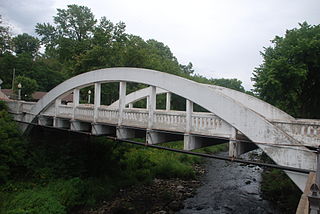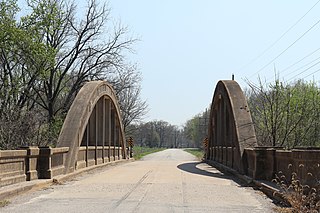
James Barney Marsh was an American engineer and bridge designer. He patented a new design for arch bridges. Marsh gave Archie Alexander, the first African-American to graduate as an engineer from Iowa State University, his first job. Marsh worked in the bridge building business for over 50 years, and several of his bridges are listed in the National Register of Historic Places.

The Rainbow Bridge is an old bridge over Brush Creek approximately two miles west of Riverton, Kansas on former U.S. Route 66 (US-66), now a county road. The bridge is a single-span concrete Marsh arch bridge and is the sole surviving bridge of this type on the entire length of the former highway. Two other Marsh arch bridges were also located on US-66 in Kansas, both over the Spring River. It was built in 1923.

Wilson River Bridge, also known as Wilson River Bridge at Tillamook or Wilson River Bridge No. 01499, is a bridge near Tillamook, Oregon, United States. The 1931 bridge was designed by Conde McCullough in the Classical Revival and Art Deco styles. It covers a span of 180 feet (55 m) and brings coastal U.S. Route 101 (US 101) over the Wilson River.

There are eight properties listed on the National Register of Historic Places (NRHP) in Linn County, Kansas. Two of the sites are the location of historic events. The Marais des Cygnes Massacre Site is the location of the Marais des Cygnes massacre, an 1858 event during Bleeding Kansas in which pro-slavery advocates kidnapped 11 anti-slavery settlers, killing five of them. John Brown temporarily used the site as a fort, and the property was listed on the NRHP in 1971. The Battle of Mine Creek Site preserves the location of the Battle of Mine Creek, which was fought in 1864 as part of Price's Raid during the American Civil War. Confederate general Sterling Price's army was retreating after being defeated at the Battle of Westport and was attacked by pursuing Union troops. Price's Confederate lost heavily in men and supplies. The site was added to the NRHP in 1973.

The Pithole Stone Arch Bridge is a 37-foot (11 m) masonry, deck arch bridge that spans Pithole Creek between Cornplanter and President Townships, Venango County in the U.S. state of Pennsylvania. The bridge was listed on the National Register of Historic Places in 1988 and was documented by the Historic American Engineering Record (HAER) in 1997.

The Christine Falls Bridge is a reinforced concrete arch bridge in Mount Rainier National Park, spanning Van Trump Creek at Christine Falls. The bridge was built in 1927–1928 by contractor J. D. Tobin of Portland, Oregon, who built the Narada Falls Bridge at the same time. The arch has a three-centered profile and spans 56 feet (17 m). The bridge is 30 feet (9.1 m) wide. It was faced with rubble stonework and is an example of National Park Service Rustic design.

The Yosemite Valley Bridges are eight bridges in the Yosemite Valley of Yosemite National Park, most of them spanning the Merced River. Five of them were built in 1928, with the remainder built between 1921 and 1933. The bridges feature a concrete structure faced with local stone, in an elliptical or three-centred arch configuration. They are notable for their uniform character and for their conformance to tenets of the National Park Service rustic style. Design work for the seven newer bridges was by George D. Whittle of the San Francisco District Office of the U.S. Bureau of Public Roads for the National Park Service. Concrete bridges were chosen at the urging of Thomas Chalmers Vint of the Park Service, in lieu of alternative designs for steel truss bridges, or suspension bridges suggested by the park superintendent.

The Marsh Rainbow Arch Bridge is a historic bridge over Duncan Creek located in Chippewa Falls, Wisconsin. It was added to the National Register of Historic Places in 1982.

The EDL Peloux Bridge near Buffalo, Wyoming, is a Pratt pony truss bridge that was built in 1912 by the Canton Bridge Company. The bridge carries Johnson County Road CN16-40 across Clear Creek. The single-span bridge is 81.5 feet (24.8 m) long and has a wooden roadway supported by steel pins and piles. The bridge was placed on the National Register of Historic Places in 1985 as part of a Multiple Property Submission devoted to historic bridges in Wyoming The bridge was relocated to Buffalo City Park in 1986.
The Miller Ree Creek Bridge is a historic bridge in Miller, South Dakota. It is a single-span Marsh rainbow arch concrete bridge, carrying 2nd Street over Ree Creek just west of the town. The bridge consists of two concrete arches, from which the floor supports are suspended. The bridge is 42 feet (13 m) long and 22 feet (6.7 m) wide, rising about 10 feet (3.0 m) above the stream bed. Built in 1914, this bridge is one of only three bridges of the type to survive in the state, and is the best-preserved of the three.
The Squaw Creek Bridge was located in Harrison Township in rural Boone County, Iowa, United States. It spanned Squaw Creek for 76 feet (23 m). The Boone County Board of Supervisors awarded a contract to the N.E. Marsh & Son Construction Company of Des Moines in August 1917 for $6,278. Designed by Des Moines engineer James B. Marsh, the Marsh arch bridge was completed the same year. The bridge was listed on the National Register of Historic Places (NRHP) in 1998. It has subsequently been replaced by a new span. The bridge was removed form the NRHP in 2022.

Squaw Creek Bridge 2 is located in Harrison Township in rural Boone County, Iowa, United States. It spans Ioway Creek for 88 feet (27 m). The Marsh arch bridge was designed by Des Moines engineer James B. Marsh, and built by the N.E. Marsh & Son Construction Company of Des Moines in 1918. The bridge was listed on the National Register of Historic Places in 1998.

Beaver Creek Bridge is located northwest of Ogden, Iowa, United States. It spans Beaver Creek for 52 feet (16 m). The Marsh arch bridge was designed by Des Moines engineer James B. Marsh, and built by the N.E. Marsh & Son Construction Company of Des Moines in 1919. After it was completed it carried traffic on the Lincoln Highway. The bridge was listed on the National Register of Historic Places in 1998.
The Beaver Creek Bridge was a historic bridge located to the east of Perry, Iowa, United States. The 100-foot (30 m) span carried traffic on M Avenue over Beaver Creek. The Dallas County Board of Supervisors bought a rainbow arch bridge design from Des Moines engineer James B. Marsh. They contracted with his son Frank who owned F.E. Marsh & Co. of Jefferson, Iowa to build the bridge for $8,075. The bridge was listed on the National Register of Historic Places in 1998. It has subsequently been removed and replaced.

The Marsh Rainbow Arch Bridge, also known as the Coon River Bridge and Rainbow Bend Access, is located south of Lake City, Iowa, United States. The 271-foot (83 m) three-span bridge carried traffic on Iberia Avenue over the North Raccoon River. It was designed by Des Moines engineer James Barney Marsh in his patented rainbow arch configuration, and constructed by the Iowa Bridge Company in 1914 for $10,970. It replaced a Howe truss bridge that had been built by the King Bridge Company of Cleveland. That bridge was put in service upstream and remained in use until 1983 when it was taken down. The Marsh arch bridge was bypassed in 1985, and remains in place in a county park. It was listed on the National Register of Historic Places in 1989.

The Dunkerton Bridge is a historic structure located in Dunkerton, Iowa, United States. The span carried a local street over Crane Creek for 212 feet (65 m). The three-span, filled spandrel arch bridge was built by the Marsh Engineering Company of Des Moines in 1909. It replaced an older span at a different location. The bridge served as the major entry point into the town from the north. This bridge was also replaced by a newer bridge to the east, and this span now carries pedestrian traffic between Charma Park and Marble Street into downtown Dunkerton. It was listed on the National Register of Historic Places in 1998.

The Mine Creek Bridge, located east of Mound City in Linn County, Kansas, was built in 1927. It was listed on the National Register of Historic Places in 1983.

The West Sixth Street Bridge is a historic stone arch bridge in downtown Austin, Texas. Built in 1887, the bridge is one of the state's oldest masonry arch bridges. It is located at the site of the first bridge in Austin, carrying Sixth Street across Shoal Creek to link the western and central parts of the old city. The bridge was added to the National Register of Historic Places in 2014.

The Cedar Creek Bridge near Elgin, Kansas, on FAS 96, was built in 1927. Also known as Elgin Cedar Creek Bridge, it was listed on the National Register of Historic Places in 1983.

The Neosho River Bridge, near Hartford, Kansas, United States, was built in 1926. It was listed on the National Register of Historic Places in 1983.



















